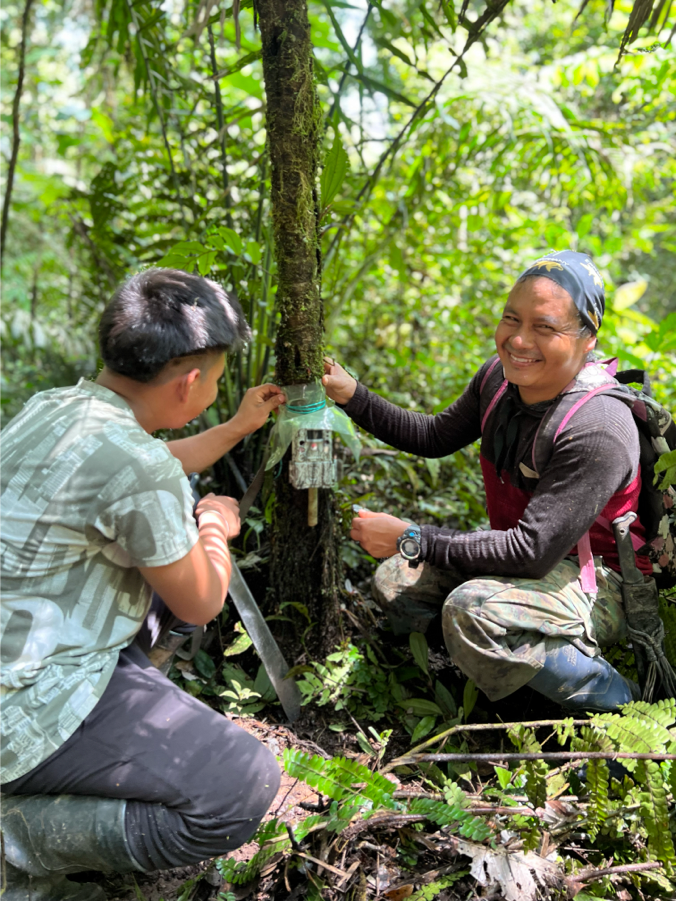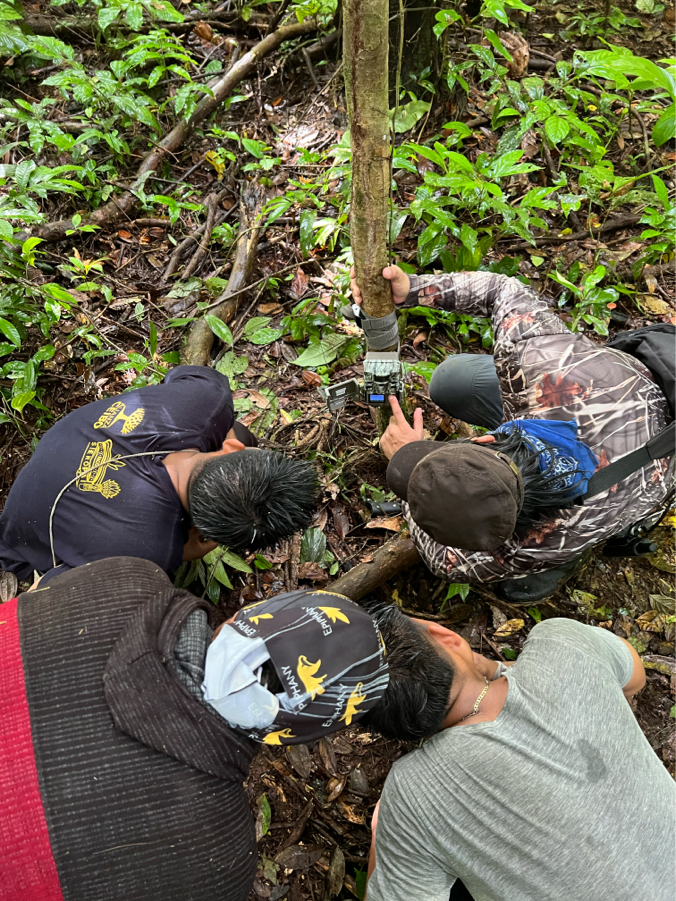As our planet moves through multiple intensifying ecological crises, it is time for comprehensive changes in the ways we address biodiversity conservation and climate change. The success of this transformation depends on whether or not the autonomy and rights of Indigenous Peoples are recognised, respected and implemented.
Grounded Resistance
Now pause. Take a moment. Imagine your territory. The place that allows you to live, providing you with water, food, medicine, shelter, joy. The home of your stories. The library of your knowledge and learning. The houses of your families, the homes of your ancestors.
Now imagine being removed from that homeland. Imagine you, and the remaining members of your family, being forced to live in a small fraction of what once was your homeland, which is now crossed by polluting trucks, by companies who push oil drills into the earth and cut trees to make way for palm plantations. This is the reality for the Siekopai people.
In the Upper Amazon lies the sacred homeland of the Siekopai nation, who have for centuries resisted cultural and physical extinction, surviving colonial wars, forced displacement and invasions. Whether by outsmarting Portuguese colonists with their knowledge of forest slopes, or enduring missionaries and rubber tappers, they have always been resilient and adapted, crafting new strategies to protect their territory.
Today the Siekopai face new colonial threats from extractivism: oil companies, miners, poachers, and more recently, palm oil developers. Palm plantations are clearing thriving forests to make way for a monocrop, forcing animals including tapirs, lowland pacas, jaguars and giant anteaters to migrate with the receding forest. Now, only a few plantation employees, a few bird species, and the occasional lost peccary wander across what was once lush forest.
One of 12 videos capturing a group of seven poachers from the palm plantation taking a break and drinking from a river in the middle of the night. The poachers are carrying five sacks of tapir (Tapirus terrestris) meat that was poached from within the Siekopai’s ancestral territory.
The impacts don’t stop there. Highly toxic pesticides used to deforest and clear land for the palm plantations leak down waterways into rivers. Years ago, the Siekopai also began observing signs of hunting in areas closest to the palm plantation carried out by its employees. Since 2017, as part of their territorial monitoring and vigilance activities, the Siekopai have implemented various technologies and strategies – such as using camera traps, drones and radios – in order to collect evidence of these activities. All of the information gathered by the Siekopai’s monitoring team was subsequently presented to the rest of the communities during an assembly. These assemblies are an essential decision-making space and form a key element of the Siekopai Nation’s governing process.
A Wekë (Tapir, Tapirus terrestris). According to the Siekopai, at the beginning of time, the tapir was a human, the father-in-law of the God of the Siekopai – Ñañë-Paina. But due to his recklessness, the upper part of his body was transformed into that of a tapir. The tapir is recognized as endangered (EN) under Ecuador’s National IUCN Red List.
The Siekopai assembly viewed all the pieces of evidence collected by their territorial monitors, many of which came from camera traps, including footage of armed palm plantation employees carrying bags of game meat out of their territory. Maintaining the traditions of continuous resistance in previous generations, the Siekopai formulated a strategy. While monitoring activities would have to continue and become more frequent, it was clear that something else needed to be done to measure the impacts and current state of biodiversity across their territory. In order to do this the nation decided to develop a biodiversity baseline study, an analysis of the state and extent of biodiversity in their territories. This will help communicate the situation of their territory to other members of the nation as well as the world.
Strong Indigenous governance processes are key to successful conservation action. Strong governance entails Indigenous autonomy, and the ability to exercise this autonomy through traditional decision-making processes (the assembly). As these responses are determined through traditional decision-making processes they are also culturally appropriate and incorporate culturally relevant factors enabling the community to identify a threat and respond to it quickly and effectively.
Biodiversity as a Baseline for Decision-making
The biodiversity baseline study is one such response, but what does it look like in practice? Drawing on available data and equitable alliances with the scientific world, the Siekopai took it upon themselves to respond to the threats facing their territory. By using camera traps and transects (observing species numbers across a line of a territory), community members can identify species richness (total list of species), the occupancy or spatial distribution of species (the probability that an animal is found in a specific area or near other variables, like certain palm trees) and density (how many animals there are in the area). This process and research was supported by the University of Florida, Colorado State University, the University of San Francisco in Quito, Amazon Frontlines and the Ceibo Alliance.
This study has two phases. Phase one involved several workshops and the implementation of camera traps across the territories over a period of three months. Teams of Siekopai set up the camera traps, and monitored their batteries and general state during periodic intervals throughout the three months. Once all the data was captured, phase two began. Phase two (currently underway) involves transects (which they walk twice a month for a year); a “resource use” questionnaire (focusing on resource use within the territory: hunting, fishing and gathering fruits); and household surveys (to understand how resources are being used and how each household thinks they can be governed better).
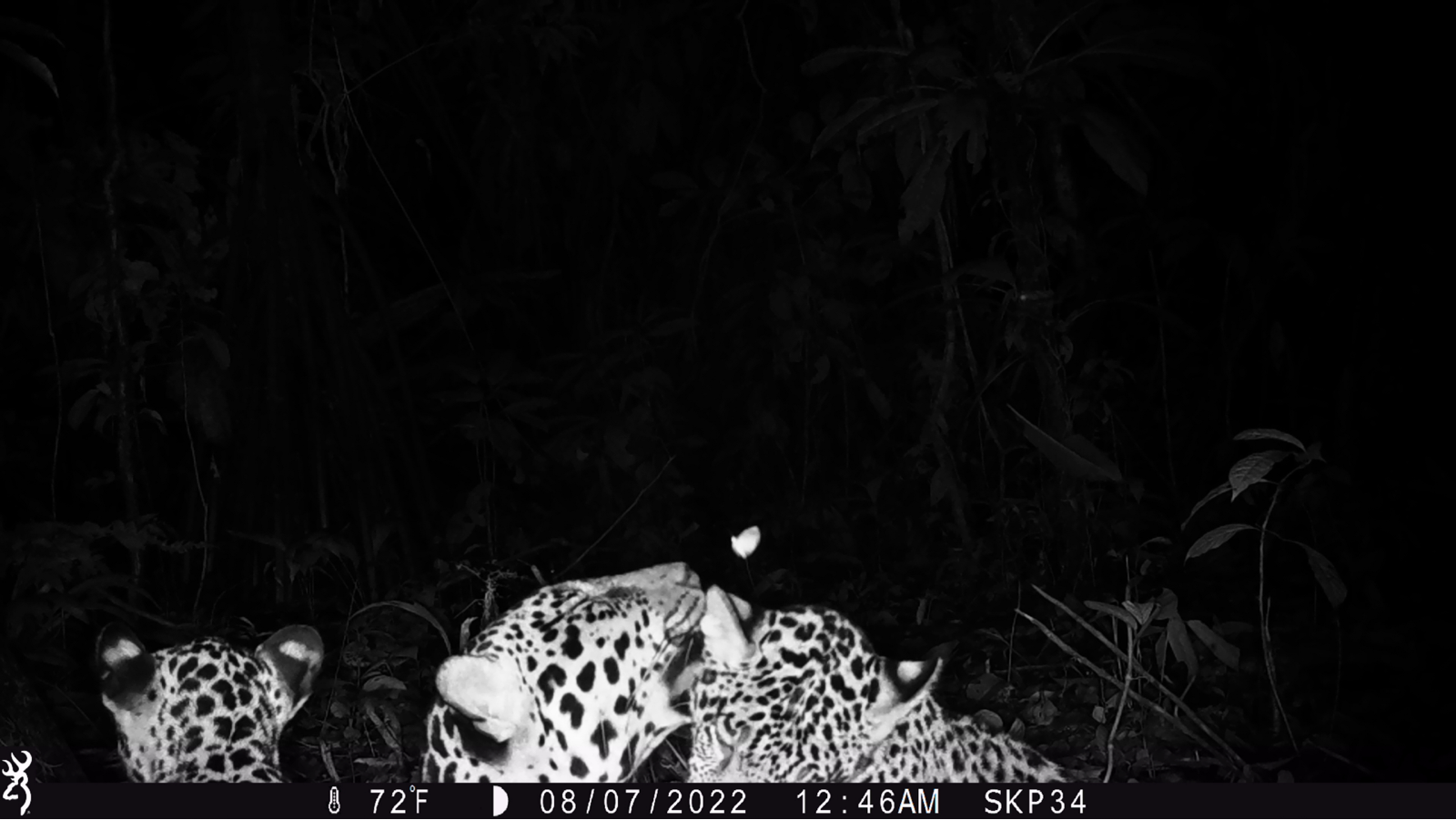
Toyayai (Jaguar, Panthera onca). A mother and two cubs. The yagé ukukë (ayahuasca drinkers/shaman) share that the jaguars who are found in groups are in fact the children of yagé ukukë. In the past the yagé ukukë transformed themselves into jaguars to communicate with beings in distant places. In kakotëkawë (a short period of sun in august) the queen of the jaguars rejuvenates and is in constant movement and contact with knowledge holders who drink yagé (ayahuasca). The jaguar is recognised as endangered (EN) under Ecuador’s National IUCN Red List.
The basis for good governance, traditional ancestral knowledge, is being lost at ever increasing rates. Each death of an ñekwë o ñeko (elder) or yagé ukukë (ayahuasca drinkers/shaman) brings with it an immeasurable loss of historical and cultural knowledge, a way of understanding the forest. Sharing and walking through territory therefore provides an opportunity for sharing knowledge and an understanding of the forest to younger generations. During the biodiversity research process, each transect is walked by two Siekopai; a technician (one of the youth supporting the filling of transect sheets) and an elder (someone knowledgeable in tracking and identifying animal tracks). By bringing youth and elders together in the territory for the study, youth can learn about the animals, stories and spirits they share the territory with. Through the biodiversity research process, many young community members are expanding their knowledge on the other values of the forest and taking on more leadership roles in territorial defence.
All these efforts are an attempt to use Western technologies and scientific vocabulary to translate Siekopai knowledge. This translation is necessary as Indigenous Peoples have been alone. Alone, fighting alone, with their knowledge brushed aside as primitive or of no value, removed from science. However, Indigenous knowledge is valid, valuable and scientific in its own right. Therefore, the role of science is to make this knowledge visible and all the actions of struggle, of care, and conservation implemented by Indigenous Peoples. To listen to what Indigenous Peoples cannot say in scientific terms, and to translate it to a global world that has been deaf to this knowledge and its effectiveness. This takes place through a conversation; an active dialogue, collaborative allyship and bilateral exchange of skills and knowledge. Scientists collaborating and working with Indigenous communities have a responsibility to provide a space for such knowledge sharing to take place.
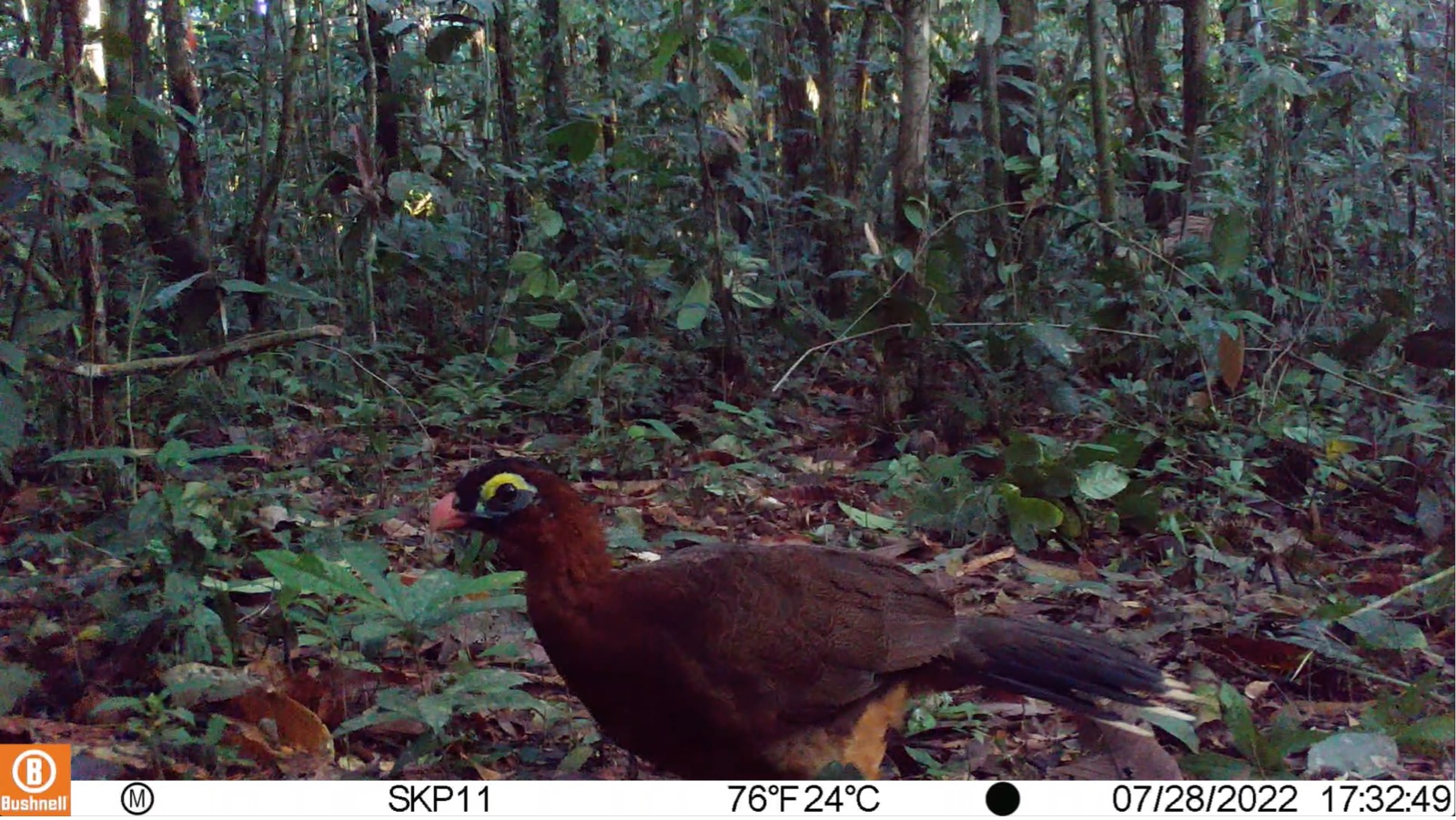
A Pëëriri, (nocturnal curassow, Nothocrax urumutum). The Pëëriri is an elusive bird, it searches for food in the morning and in the evening sings (vocalises). In the times of creation of the world, like other animals, a woman was transformed into a pëëriri for emitting cries at night due to the disappearance of her son.
Yet all too often, conservation actors with mission-oriented objectives (such as biodiversity conservation) focus on the mission (protecting biodiversity) and not the people. There is always a risk that external conservation practitioners disrupt or even disempower both Indigenous autonomy and local leadership. By doing so, conservation actors can further marginalise Indigenous Peoples, co-opting their knowledge and labour in utilitarian means to support external agendas. This external interference can damage and even hinder conservation outcomes, particularly hindering the application of an Indigenous community’s cosmovision.
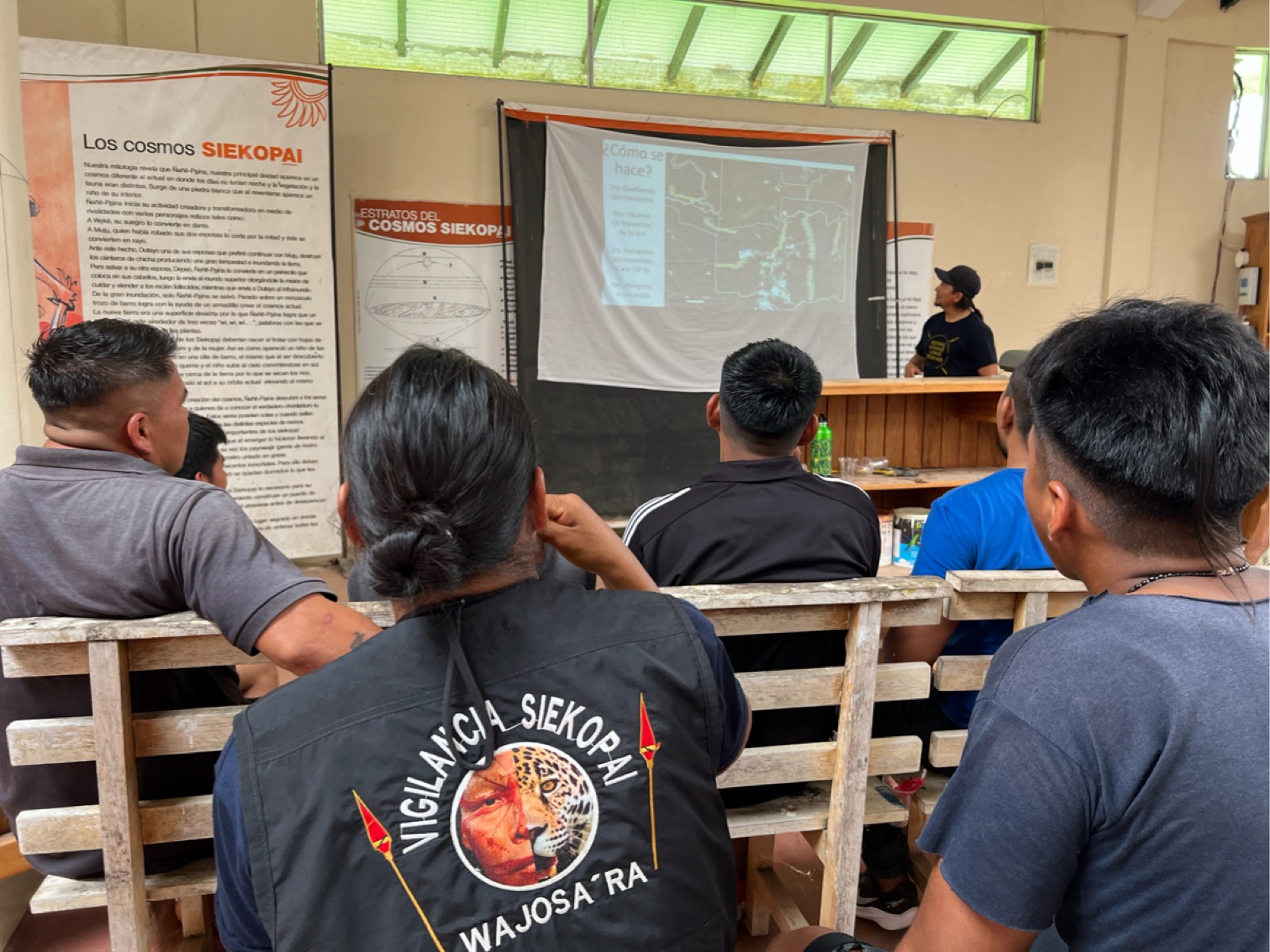
Carlos Urgiles, a researcher with the Universidad San Francisco de Quito, presenting and socializing the methodology for phase two of the Biodiversity baseline study in early 2023.
The Siekopai’s cosmology as conservation
According to the Siekopai’s cosmovision, the forest is an integral part of the human being. In other words, the forest is a humanized forest – a being just like them. The forest, and all the components that are there, all the biodiversity, even the smallest beings, have their life and live in community. The Siekopai have built their lives around their relationship with territory. For the Siekopai, conservation goes beyond the biophysical, the processes and species, and incorporates the spiritual.
The Siekopai coexist and share their territory with diverse (non-human) beings. For instance, beings such as “Okome” the governing spirit of the rivers and lagoons and who the yagé ukukë communicate with to replenish the water bodies with migratory fish, or “Makata’ñe“ who governs the animals, and brings herds of white-lipped peccary to the earth’s surface from the underworld that the Siekopai can hunt. It is therefore crucial for the Siekopai to “know” their territory and the beings within it in order to plan accordingly and govern their home which is now a fraction of what it was and is threatened. Having this knowledge is key in order to make good decisions that benefit all.
These governance decisions can be enacted through the implementation of different temporalities and spaces, such as seasonal restrictions on varying species dependent on various behaviours (mating, pregnancy, nursing) or through the zonification of hunting areas and land use planning. In the last Siekopai congress, held between the 5 – 7 of May 2023, the nationality declared an intangible zone of 10,000 ha in the middle of their territory with the intention to protect it particularly against state interests in oil extraction. This new buffer zone was named after “Ma’ñawajë”, one of the higher beings who is responsible for governing and administering the space in between the surface of the territory and tree canopy with dominion over all animals and other spirits, such as “Makata’ñe“. The relation between these beings and the Siekopai is mutually beneficial, symbiotic and codependent.
This Indigenous knowledge is crucial for conservation outcomes, yet like the territory, this knowledge is also at risk. As the extractive frontier encroaches further into the forest and the tentacles of the dominant society of capitalism and consumerism widen across the Amazon Basin, thousands of years of traditional knowledge are being threatened in a matter of generations. The stakes could not be more stark: we simply have no planetary future without the safety of ancestral knowledge systems. The safety of Indigenous knowledge systems relies on the protection of the ecosystems they are rooted in, and the protection of those ecosystems relies on the safety of Indigenous relationships with territory. It is therefore important to ensure future generations have the same possibilities of life as their ancestors and that Siekopai traditions and customs, their culture, can thrive.
Siekopai monitors installing camera traps in their ancestral territory.
Conclusion
In a rapidly changing environment, the Siekopai want to be able to respond to threats and adapt their practices. From that perspective, the biodiversity baseline study is extremely important because it is a formalised scientific way to demonstrate what the Siekopai have historically done to conserve and protect the forest that is so integral to their being and culture. By making records, by carrying out scientific studies, the Siekopai have taken a step forward in explaining to the external world, who do not understand their indigeneity and way of life, what their stewardship in the Amazon rainforest truly means. With documentation, through a scientific study that uses the language and tools of the western world, the Siekopai can demonstrate to the outer world their contributions to the forest, their permanence in it, and that it is a lived space.
There is a certain ignorance, of those who do not belong to a territory, about the forest and how Indigenous peoples relate and interact with it. For over a century, nature conservation has been defined by colonial ideas of “pristine wilderness” and “virgin natures”. Through institutions such as national parks and wildlife ranges, governments positioned nature as something which can only be protected with the removal of people (especially those deemed ‘savage’ or ‘inferior’ people). This colonial understanding of ecology has led to the coerced removal of Indigenous Peoples from environments they have nurtured and fostered over millennia. The Siekopai and their scientific allies are demonstrating another way, a more equitable way of conserving and stewarding the remaining environment.
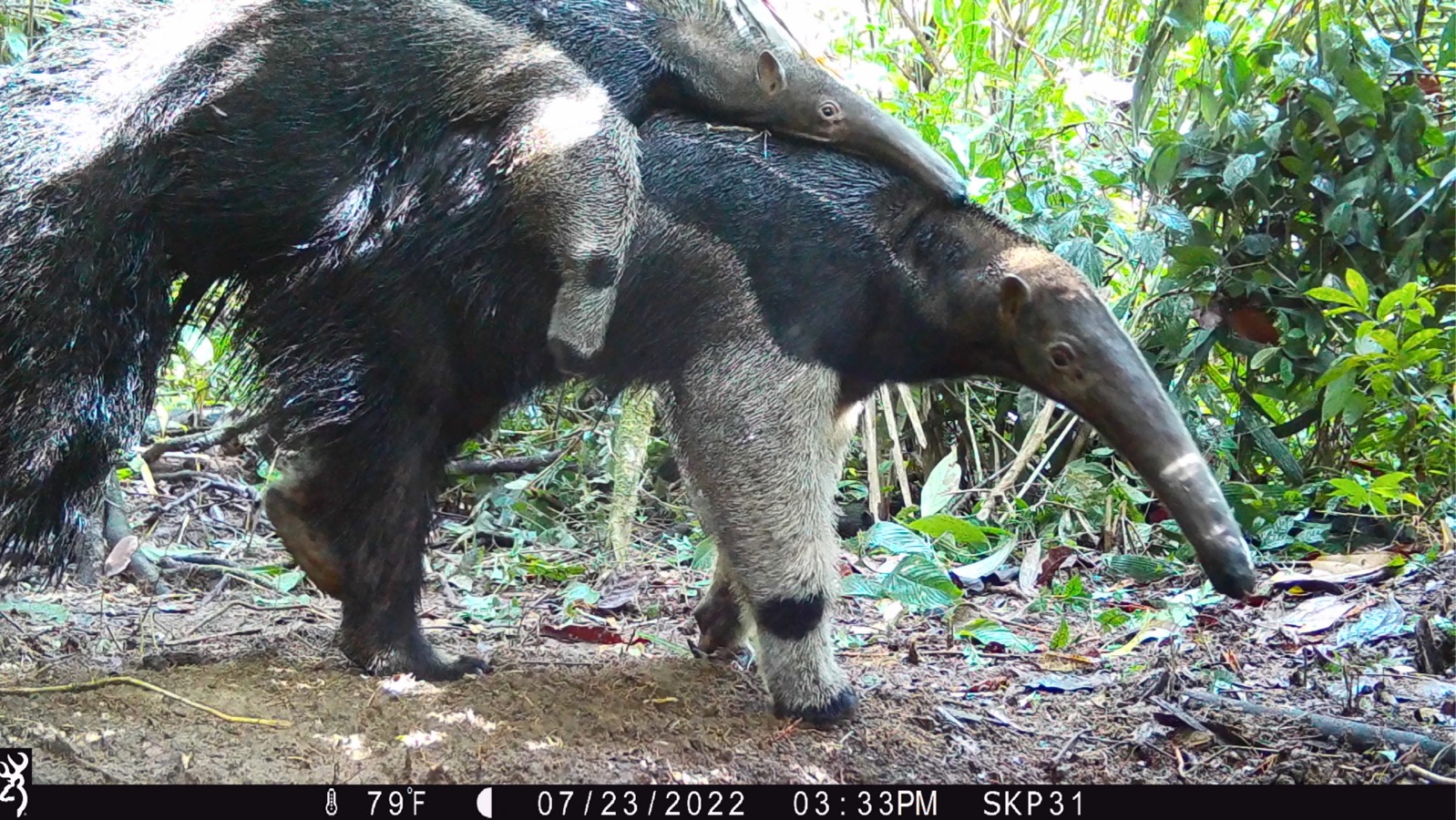
A Mie (Giant Anteater, Myrmecophaga tridactyla). Mother giant anteaters carry their pups for up to a year or until the pup is over half her size. The yagé ukukë (ayahuasca drinker/shaman) say that seeing the Mie in the visions of yagé (ayahuasca) represents the spirit of courage, one that does not fear any opponent. The Giant Anteater is recognised as vulnerable (VU) under Ecuador’s National IUCN Red List.
Human beings need other beings and ecologies, just as those beings and ecologies need human beings. Protecting landscapes means protecting the self-determination and autonomy of Indigenous Peoples. Indigenous-led strategies are the bedrock, the stable ground of successful conservation initiatives. There are 1.8 billion people living in areas of conservation importance covering 40 % of the Earth’s terrestrial area; the vast majority are Indigenous Peoples. Yet most Indigenous ancestral lands remain unrecognised, unprotected by national laws and therefore at risk from extractive and even foreign conservation interests.
A more holistic form of conservation is needed to conserve the relationships in territories. Social considerations are vital to the success of future conservation strategies and supporting equitably governed placed- and rights-based processes are essential to ensuring we can collectively live in harmony. Global decisions impact local realities and struggles.
A biodiversity study like that of the Siekopai’s is key. Getting a better sense of a territory’s diversity, and its state is fundamental to a community’s politics. How can the Siekopai plan a life together, how can they co-exist, co-live with other beings, if they don’t know about them and how their habits and lives are changing? The Siekopai all sense and feel that their territory is transforming in response to atmospheric changes and human destructions, yet having data to verify this intuition, and transmit it to the world, is essential for an Indigenous nationality who are at risk of extinction.
Top Image: Robinson Piaguaje, also known as “Chamáncito” (the little shaman), setting up a camera trap as part of the biodiversity base-line study in his ancestral territory. Robinson is one of the few young Siekopai interested in learning and practising yagé (ayahuasca). Photo taken by Carlos Urgiles in Secoya Remolino (2022) as part of the Conterritorio (convivencia basada en el conocimiento para la conservación) Project.

